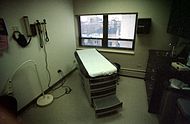- Ambulatory care
-
Ambulatory care is a personal health care consultation, treatment or intervention using advanced medical technology or procedures delivered on an outpatient basis (i.e. where the patient’s stay at the hospital or clinic, from the time of registration to discharge, occurs on the same calendar day).[1][2][3]
Many medical investigations and treatments for acute illness and preventive health care can be performed on an ambulatory basis, including minor surgical and medical procedures, most types of dental services, dermatology services, and many types of diagnostic procedures (e.g. blood tests, X-rays, endoscopy and biopsy procedures of superficial organs). Other types of ambulatory care services include emergency visits, rehabilitation visits, and in some cases telephone consultations.[4]
Ambulatory care services represent the most significant contributor to increasing hospital expenditures and to the performance of the health care system in most countries, including most developing countries.[5][6]
Contents
Ambulatory care settings
Health care organizations use different ways to define the nature of care provided as "ambulatory" versus inpatient or other types of care.[4][5][7][8]
Sites where ambulatory care can be delivered include:
- Doctor's surgeries (known as doctor's offices in American English): This is the most common site for the delivery of ambulatory care in many countries, and usually consists of a physician's visit. Physicians of many specialties deliver ambulatory care. These physicians include specialists in family medicine, internal medicine, obstetrics, gynaecology, cardiology, gastroenterology, endocrinology, ophthalmology, and dermatology.
- Clinics: Including ambulatory care clinics, polyclinics, ambulatory surgery centers, and urgent care centres.
- In the United States, the Urgent Care Association of America (UCAOA) estimates that over 15,000 urgent care centers deliver urgent care services. These centers are designed to evaluate and treat conditions that are not severe enough to require treatment in a hospital emergency department but still require treatment beyond normal physician office hours or before a physician appointment is available.
- In Russia and other countries of the former Soviet Union, Feldsher health stations are the main site for ambulatory care in rural areas.[9]
- Hospitals: Including emergency departments and other hospital-based services such as day surgery services and mental health services.
- Hospital emergency departments: Some visits to emergency departments result in hospital admission, so these would be considered emergency medicine visits rather than ambulatory care. Most visits to hospital emergency departments, however, do not require hospital admission. Many of these visits are not true emergencies and are better seen in an urgent care center.[citation needed]
- Non-medical institution-based settings: Including school and prison health; vision, dental and pharmaceutical care.[citation needed]
Revisit
One or more planned revisits to settings of ambulatory care is the main method of follow-up of previous care in both ambulatory and inpatient settings. It can be regarded as an intermediate level of follow-up between continuous monitoring in an inpatient setting on one hand, and the situation where an individual is advised to return only when (or if) symptoms appear or reappear on the other.
See also
References
- ^ William Osler Health System. What is “Ambulatory Care”? Accessed 25 July 2011.
- ^ Saskatoon Health Region. Programs & Services: Ambulatory Care. Accessed 25 July 2011.
- ^ The Free Dictionary. Ambulatory care. Accessed 25 July 2011.
- ^ a b Canadian Institute for Health Information. Comprehensive Ambulatory Care Classification System. Accessed 25 July 2011.
- ^ a b Karpiel MS. "Using patient classification systems to identify ambulatory care costs." CBS Business Network. Accessed 25 July 2011.
- ^ Berman P. "Organization of ambulatory care provision: a critical determinant of health system performance in developing countries." Bulletin of the World Health Organization, 2000, 78 (6).
- ^ Verran JA. [http://onlinelibrary.wiley.com/doi/10.1002/nur.4770090404/abstract "Testing a classification instrument for the ambulatory care setting." Research in Nursing & Health, 9(4): 279–287, December 1986 - DOI: 10.1002/nur.4770090404
- ^ Alberta Health and Wellness. Alberta Ambulatory Care Reporting Manual. Edmonton, April 2009.
- ^ Shabarova Z. Primary Health Care in the NIS: Soviet Primary Health Care system review. Accessed 25 July 2011.
External links
Categories:- Medical specialties
Wikimedia Foundation. 2010.

